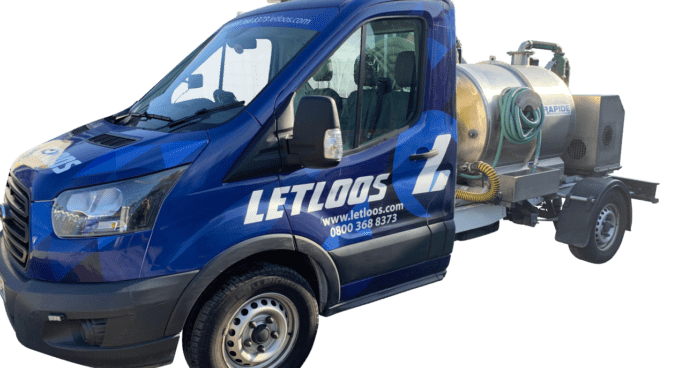- Portable Toilets Guide
- Portable toilet: What is it and how does it work?
- Types of toilets: What is the right choice for you?
- How much does it cost to hire a portable toilet?
- Portable toilet requirements and regulations
- How many portable toilets do I need for my event?
- How to clean a portable toilet? A complete guide
- How to empty portable toilets?
How to empty portable toilets?

If you find yourself wondering where and how to empty a portable toilet or septic tank, this article will help. Septic tanks need emptying less often than portable toilets, which should be emptied once a week at least. But there’s much more to ensure you’re doing things safely and hygienically…
Signs your septic tank is full
A septic tank collects and stores waste at sites that are not mains connected. These sites can include temporary construction sites, rural properties, and semi-permanent event sites. Septic tanks should be emptied frequently. You can tell if your septic tank needs emptying by these key signs…
Your toilets often back up or don’t flush properly
If flushing your toilets is a struggle, your septic tank may be full. If only one toilet in your house isn’t flushing properly, it’s likely a problem with that specific toilet. If all your toilets won’t flush, your septic tank is probably full.
Equally, if you notice sewage backing up into your drains and toilet, you need to get your septic tank emptied as soon as possible.
Your pipes drain slowly or noisily
Your septic tank might be full or clogged if your toilets are draining slowly or if they make a loud gurgling sound. You can always call a septic tank drain cleaner to check if there are any tank blockages. That said, if water continues to drain slowly after this appointment, it’s likely the septic tank is full and needs emptying.
The environment of the septic tank begins to smell like sewage
If you notice a sewage-like smell in the area around your septic tank, it’s very likely that the tank is full and needs emptying.
Water pooling in the environment surrounding the septic tank
If you notice water pooling in the area around your septic tank, the tank may be overflowing and need emptying.
How often should you empty your septic tank?
Different kinds of septic tanks need to be emptied with different frequencies. As an average, you should aim to empty your domestic septic tank once every three to five years.
The rate at which you need to empty your septic tank will depend on many factors. These can include the number of people using the sanitation facilities or whether the tank is at home or on a temporary construction or event site. The more these facilities are used, the more frequently the septic tank will need emptying.
Should you empty it yourself or hire a company?
Hiring a company to empty your septic tank is the best way to ensure that the job is done properly and hygienically.
LetLoos offers septic tank emptying solutions and can cater to your specific needs. We can empty and remove septic waste from both small-scale domestic models through to commercial tanks.
Our team are dependable and professional. We use high-grade equipment to empty all septic waste in a reliable, hygienic fashion. We’ll also dispose of the waste following legal and environmental regulations.
Preparing to empty the portable toilet
Chemical or mains-connected toilets are emptied differently.
Chemical portable toilets push all waste down into a leak-proof holding tank. As such, they need to be emptied regularly – usually once a week.
Mains-connected portable toilets operate like the toilets you have at home, so they are directly connected to a sewage system and don’t need emptying.
At LetLoos, we use high-quality equipment to remove your waste hygienically. It will be transported to a sewage processing plant. Our team will also clean the toilets and add the chemical effluent that sanitises each facility.
How to empty a portable toilet?
Below, we will briefly guide you through emptying a portable toilet in a caravan. We also advise the best way to empty freestanding chemical facilities.
You should know the location of all authorised waste disposal sites before emptying any toilet. Always take care to follow the correct safety procedures.
Steps for emptying the camping toilet
The best camping toilets will have two separate tanks – the fresh water and the waste tank.
Transport the waste tank to the authorised disposal area in your campsite, and empty the contents.
Use an available hose or tap to swill freshwater around the tank and empty it again.
Before putting the waste tank back into place, ensure that you mix in a disinfectant.
Steps for emptying the portable toilet
If you wonder, ‘where do you empty a portable toilet’, the answer is always at a regulated treatment plant.
That’s why it’s best to rely on a professional sanitation company to empty freestanding portable toilets.
If you choose to book portable toilets with LetLoos, we regularly send a tanker around to the location of your portable toilets. The tankers empty out waste effluent, transporting it to a Thames Water treatment plant for processing. We are regulated and licensed by the Environment Agency to remove waste safely.
Safety tips for emptying toilets effectively
Always ensure that you are wearing gloves and PPE when emptying a portable toilet. If you’re emptying a caravan or camping toilet, having a waste tank with a latch or spout can help to reduce the risk of splashing.
Only ever empty a portable toilet at authorised waste disposal locations. This will likely be called a Chemical Disposal Point (CDP) or Elsan Point on a campsite.
Otherwise, you can rely on a professional sanitation company like LetLoos to empty your portable toilets.
Conclusion
If you’re based in London, Essex, and Liverpool and are looking for a professional service to remove and empty portable toilet waste, look no further than LetLoos.
We empty both your septic tank and portable toilets as hygienically and efficiently as possible. Once we’ve emptied the facilities, we’ll transport the waste to an authorised sewage plant for processing. We’ll also clean and disinfect the facilities, ensuring that they’re ready for ongoing use.

